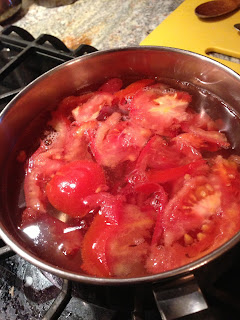Okonomiyaki is a popular dish in Japanese. Okonomi means your choice. Yaki means fried or grilled.
 |
| Okonomiyaki, or the Japanese version of pizza |
 |
| Okonomiyaki batter |
The recipe is easy peasy. The cabbage in the batter makes it filling and nourishing. If seafood isn't your thing, use shredded pork, chicken or beef. The pancake itself has a mild taste, like many other Japanese dishes. The punch of flavour comes from the condiments and garnish, such as green onion, spicy mayonnaise or oyster sauce.
 (makes one large pancake for 4-6)
(makes one large pancake for 4-6)Batter:
1 cup all purpose flour or rice flour
1/2 cup fish stock (see note below for quick fish stock)
1 egg
2 cups shredded cabbage or roughly 1/4 of a head of cabbage
1 cup of seafood (I use frozen assorted shrimp, scallops, mussels, octopus thawed in warm water)
Garnish:
Chopped green onion
Mayonnaise
Oyster sauce
1. Combine the flour, stock and egg in a medium bowl.
2. Fold in the cabbage.
2. Heat a lightly greased frying pan over medium heat.
3. Scoop the batter into the hot pan.
4. Arrange the thawed seafood into the batter.
5. When bubbles appear on the surface, carefully flip the pancake.
Enjoy your okonomiyaki warm, topped with chopped scallions, mayonnaise and oyster sauce.
Note: For a quick stock, add 2 teaspoons of Hondashi (powdered Japanese fish stock) to 1/2 cup of warm water. If you're using meat instead of seafood, substitute the fish stock with vegetable or meat broth.


























